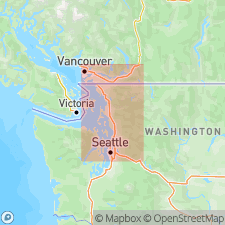
- Usage in publication:
-
- Red Mountain subgroup [informal]
- Modifications:
-
- Named
- Dominant lithology:
-
- Argillite
- Siltstone
- Limestone
- AAPG geologic province:
-
- Cascades province
Summary:
Pg. 489. Red Mountain subgroup [informal] of Chilliwack Group. Consists of lower argillite-siltstone unit (312 to 625 m [825 m?] thick in Washington) and upper limestone unit (1 to 200 m thick) which contains abundant microfauna, brachiopods, bryozoans, and corals. Fusulinids indicate Early Pennsylvanian age for limestone. Overlies Sumas Mountain subgroup [informal] (new); underlies Black Mountain subgroup [informal] (new) (both of Chilliwack Group). Age is Early Pennsylvanian.
Type area: quarry exposures on Red Mountain and Black Mountain, Whatcom Co., WA. Extends north into Chilliwack region of British Columbia.
["Subgroup" not recognized as a formal stratigraphic rank term (CSN, 1933; ACSN, 1961, 1970; NACSN, 1983, 2005, 2021). Considered informal and should not be capitalized.]
Source: US geologic names lexicon (USGS Bull. 1564, p. 140-141); supplemental information from GNU records (USGS DDS-6; Menlo GNULEX).
For more information, please contact Nancy Stamm, Geologic Names Committee Secretary.
Asterisk (*) indicates published by U.S. Geological Survey authors.
"No current usage" (†) implies that a name has been abandoned or has fallen into disuse. Former usage and, if known, replacement name given in parentheses ( ).
Slash (/) indicates name conflicts with nomenclatural guidelines (CSN, 1933; ACSN, 1961, 1970; NACSN, 1983, 2005, 2021). May be explained within brackets ([ ]).

